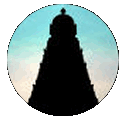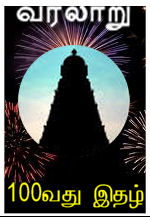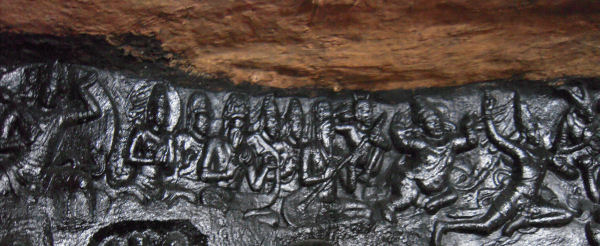 |
 |
 |
http://www.varalaaru.com A Monthly Web Magazine for South Asian History [176 Issues] [1745 Articles] |
 |
 |
 |
http://www.varalaaru.com A Monthly Web Magazine for South Asian History [176 Issues] [1745 Articles] |
|
Issue No. 100

இதழ் 100 [ அக்டோபர் 2013] நூறாவது இதழ் 
இந்த இதழில்.. In this Issue.. 
|
Series:
Pudukkottai Cave Temples
Pallikondaruliya Azhvar Shrine[Cont.]
Figures in the Upper Stratum Figures in the upper stratum are rishis, devas, divine musicians, celestial beings and the weapons of Vishnu. It can be divided into northern wall, eastern wall and western wall sculptures. The northern wall panel starts and ends with the luminaries, that is, Surya and Chandra. Devotees are shown in the eastern and the western walls. Brahma forms the central figure of the northern wall and he is flanked by Dakkan and Agni near his heads and they three form a group in the mid region. The figures to the west of Brahma are eleven which starts with a Luminary and ends with Dakkan, as like, to the east of Brahma constitutes twelve which starts with Agni and ends with a Luminary.  Figures in the upper Stratum Brahma Brahma is seated in ardhapadmasana on the lotus which raise on a thick and lengthy stalk.[30] The lotus is well bloomed with its outer whirl drooping down and inner whirl straight upward in which Brahma is seated. In the visible three heads the locks are arranged as jatamakuta, pootukundala adorns left ear and makara kundala the right ear, charapali, udarabandha, bangles, armlets are the other ornaments worn by him. He is clad in pattadai and the vastra yajnopavita is worn in niveta fashion. Among the front hands the right is showing kataka and the left is in dyana mudra, whereas his back hands carry kamandalu in the right and akshamala in the left which is in kataka. An umbrella is shown above his heads. Dakkan and Agni Immediate to Brahma near his right head is the goat faced Dakkan. Charapali, bangles, and armlets are the ornaments adorn him. His right hand is in kataka whereas the object[31] in his left hand is unidentified. He is shown with sharp horns. Agni is near the left face of Brahma carrying flames in both his hands. His hair styled as flames and wearing pootukundalas in the ears, charapali around the neck. Figures to the West of Brahma Luminary in the West The Luminary in the west[32] is seated on the folded legs which are spread apart. His head arranged as jatamakuta in which the left over locks are formed as loops. The silk dress worn by him is fastened by hip belt and the idaikattu is loosely worn above it with knots on the sides. Charapali, udarabandha, bangles, makara kundalas are the ornaments worn by him. Yajnopavita is worn in niveta. His right hand is holding a bud that is rested on his right shoulder whereas his left hand is raised above and eulogizing the presiding deity. A big halo is shown behind him. Female with Halo The female[33] next to the luminary is in anjali hasta and seated in same posture as her previous counterpart. Her locks are arranged as jatamakuta in which the free floating locks are beautifully formed as loops upto her waist. Charapali, bangles, armlets are the ornaments worn by her. In her elongated ears the right is adorned with patrakundala and the left is adorned with pootukundala. Her lower garment is pattadai fastened by hip belt and idaikattu above it. Breast band is absent. Unlike her previous counterpart the halo is shown only for her head The Divine Musicians - Thumburu - Narada Musician with Yazhl and his Disciple The musician next to the female figure is an aged rishi[34] seated in the forefront and a young disciple is seen behind to his right. The rishi is seated in cross legs with his left hand holding the stalk of the yazhl while his right hand is in kataka near his chest. The fish shaped yazhl is resting near his folded legs in which its stalk raises like a bow to his left. His ears are elongated, head styled as jatamakuta and also having beard and mustache. Charapali adorns his neck; vastra yajnopavita worn in niveta fashion to which a heavy knot is formed on his left shoulder. The male behind him is a young rishi in jatamakuta and elongated ears; might be his disciple. He is partially covered by the rishi and hence only his right side is visible in which charapali and vastra yajnopavita are seen. His right hand is in kataka. Musician with Veena and Disciples Next in the forefront is a rishi with veena[35] and two disciples behind him. The aged rishi is seated in folded legs, holding the veena in his hands. His ears are elongated and locks are arranged as jatamakuta and also shown with beard and mustache. He is wearing beaded mala and bangles. Vastra yajnopavita is worn in niveta with knots on the left shoulder. The pot of the veena is resting on the floor adjoining his right leg and the stalk of the instrument is extending beyond the shoulder of the following figure which has an orbed tip. While his left hand is handling the veena his right hand is resting above it in kataka. Behind him two disciples are shown, the disciple immediate to him is wearing vastra yajnopavita and his right hand is in kataka. The second disciple is visible only upto his neck. Both their ears are elongated with kundalas and their locks are arranged as jatamakuta with few remain untied. Male Figure The male figure[36] next to the sage with veena is standing on his right leg and his left leg folded, raised up to his chest which is also held by his left hand. His right hand is raised upto his shoulder and holding a pitcher which is resting on his right shoulder whereas his left hand is showing pathaka. With loin wear, fuzzy chin and mustache, his head is adorned with spikes.[37] Bangles, anklets, and flower stud in unstretched ears are the ornaments adorn him. The sacred cord is from right to left and unlike yajnopavita it is running tightly along the chest.38 Foot notes : 30. It is said that Brahma takes birth on the lotus that issue from the navel of Lord Vishnu. Periyazhlwar recite it as “உய்ய உலகு படைக்க வேண்டி உந்தியிற் தோற்றினாய் நான்முகனை” (427) 31.Might be big bloomed lotus. 32.ibid., மு.நளினி, இரா.கலைக்கோவன், The authors have placed the Surya and Chandra as per their direction and suggested the Luminary in the west can be taken as Chandra. 33.ibid., மு.நளினி, இரா.கலைக்கோவன், according to the authors she is Rohini, wife of Chandra. 34.ibid., மு.நளினி, இரா.கலைக்கோவன், The authors deemed the musician with yzhal as Thumbru and at the same time suggested that he can also be taken as Narada. P.216 35.ibid., மு.நளினி, இரா.கலைக்கோவன், The authors deemed the musician with veena as Narada at the same time can also be taken as Thumbru. P.217. It is understood from the literary tradition that both the instruments are applicable to both the musicians “நன் நரம்பு உடைய தும்புருவோடு நாரதனும் தம் வீணை மறந்து', 'இணையில்லா இன்னிசை யாழ் கெழுமி இன்பத் தும்புருவும் நாரதனும் இறைஞ்சி ஏத்த..” While comparing the Malayadipatti and Thirumeyyam Thumbru-Narada slight variation is seen; the Musicians of Malayadipatti are shown as flying figures and also without disciples. While at Thirumeyyam both are aged with beard and mustache, whereas at Malayadipatti only one is shown aged with beard and mustache and the other one looks young. While kataka as hasta in Thirumeyyam, eulogizing at Malayadipatti. As like Thirumeyyam two different instruments are shown. 36.ibid., மு.நளினி, இரா.கலைக்கோவன், according to the authors he is in Dandapaksha karna. 37.ibid., மு.நளினி, இரா.கலைக்கோவன், according to the authors if the head adornment is chakra he can be deemed as Chakrathalvar. 38.ibid., மு.நளினி, இரா.கலைக்கோவன், ‘chhannavira’. this is txt file� |

சிறப்பிதழ்கள் Special Issues 

புகைப்படத் தொகுப்பு Photo Gallery 
|
| (C) 2004, varalaaru.com. All articles are copyrighted to respective authors. Unauthorized reproduction of any article, image or audio/video contents published here, without the prior approval of the authors or varalaaru.com are strictly prohibited. | ||